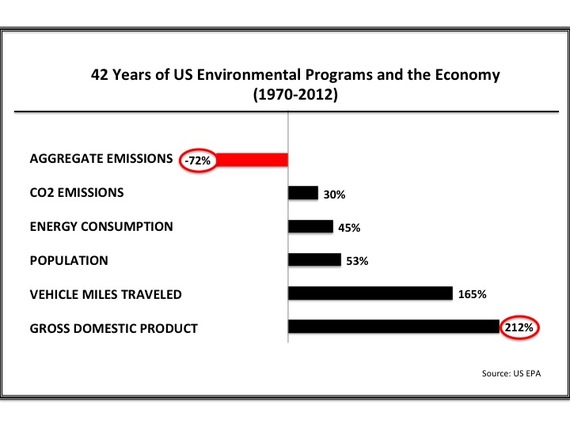In an age of remarkably divisive politics, even something as basic as clean air, land and water has become politicized. If we used the presidential election results as a proxy, half of the country apparently thinks that making "America Great Again" involves crushing the Environmental Protection Agency. And, the other half believes the exact opposite.
President-elect Trump, let me suggest a way to get past this standoff. On the campaign trail, you said many things that you have since retracted or re-thought. You said you were going to aggressively pursue criminal charges against Hillary Clinton, make Mexico pay for a wall, ban Muslims and deport all illegal immigrants. You have since pivoted on all of these issues. Perhaps this same pragmatism and business sense will make you reconsider your promise to shut down the EPA as well.
You are businessman and I think we can agree that business is all about results. So before Scott Pruitt, your new EPA administrator, starts gutting his agency, let's look at it with a clear, business perspective: How does the EPA impact Americans' lives, their economy and their pocketbooks?
The facts may prove surprising.
EPA programs have helped Americans become healthier and more productive
Since President Nixon created the EPA in 1970, lakes and streams across America have been cleansed of pollution, rivers like the Cuyahoga do not catch fire due to spills, and our schools do not have to shut down daily because of polluted air. In the pre-EPA days, hazardous materials were disposed of, well, haphazardly. Today you are unlikely to discover that your new home is sitting on top of a toxic waste dump that makes you and your family terminally ill.
Unlike the haze-infested air of the 1950's and 60's, a typical day in Los Angeles is clear and the sky is blue. It's easy to forget how horrible air quality was in American cities just 50 years ago, when smog shut down schools and factories. But, if you want an idea, look at recent photos of Beijing or Delhi. Just this week, Beijing and its surrounding cities had another pollution "red alert", shutting down 700 factories, power plants and restricting cars. "The smog has serious repercussions on the lungs and the respiratory system, and it also influences the health of future generations, so under a red alert, it is safer to stay at home rather than go to school," said a young Chinese 15 year student, who had to stay home from school.
Nearly million people die prematurely every year from air pollution just in India and China. Without the EPA, those conditions could be found in New York or Los Angeles. Instead, America has a record of cleaning up air pollution unmatched around the world.
A cleaner environment comes with huge public health benefits. For example, a 2010 study revealed that reductions in fine particle and ozone pollution avoided more than 160,000 premature deaths, 130,000 heart attacks, millions of cases of respiratory problems such as acute bronchitis and asthma attacks, and 86,000 hospital admissions. The reductions in air pollution prevented 13 million lost workdays, improving worker productivity, which contributes to a stronger economy. It also helped the next generation of workers, avoiding 3.2 million lost school days for kids due to respiratory illness.
Healthier Americans are good for our nation.
EPA standards are a bargain
Businessmen are always looking for a good return on investment. America's environmental protections are a steal. The public health benefits of a cleaner environment and a healthier workforce are far greater than the costs of achieving them. By 2020, for example, the benefits of enforcing the 1990 Clean Air Act will likely exceed compliance costs by a factor of 30 to 1. A recent 2013 study by the Office of Management and Budget that examined the cost benefits of EPA regulations over the last decade found that $45 billion in costs drove as much as $640 billion in benefits.
You may not be aware that the US has already acted in a significant way to reduce greenhouse gas emissions that saves consumers trillions. A program which is improving fuel efficiency while reducing greenhouse gases also is already on the way to generating as much as $1.7 trillion savings for drivers based on an investment of around $150B by the automotive industry. Consumers have more money in their pockets while the planet is spared four billion tons of additional carbon dioxide.
It doesn't matter if you are a politician, environmentalist or businessman: This is a win-win.
EPA standards promote innovation
Because EPA protections create markets for new solutions, companies are encouraged to invest in groundbreaking technology from power plants, factories and cars.
Even more impressive: this innovation has made America great. Our country is the world leader in production and consumption of environmental protection technology. In 2008, the environmental technologies and services industry supported 1.7 million jobs and generated $300 billion in revenues. And these jobs are typically high value and well paying - just what your supporters asked for on the campaign trail. The Bureau of Labor Statistics reports that demand for environmental engineers who already command an annual average $85K, will grow faster than the national average for all occupations between 2014 and 2024, increasing by 12 percent.
So, just how do these protections lead to innovation? Let's look at one of the earliest EPA successes, a 1970's vehicle emissions rule. The requirement that cars clean up their exhaust spurred a race between American corporations to develop effective, durable catalytic converters. America pioneered this technology; today it is found the world over. More recently, electronic fuel injection systems were developed to make cars more efficient and reliable. Gasoline direct injection (GDI) technology was used in less than 3% of cars in 2008 models. This year, the innovation will be found in half of all new cars. Environmental protections also prompted the development of powerful but compact turbocharged engines and silky smooth eight speed transmissions.
The EPA is playing an important role in the future of auto technology. Twenty years ago, barely anyone knew what a hybrid car was. As of last year, there were 76 alternative propulsion vehicle models available to consumers in the US market, from hybrids, plug in hybrids, battery electrics and even fuel cell vehicles. The affordable all-electric Chevrolet Bolt is the Motor Trend 2017 Car of the Year.
All of these innovations were the result of private industry know-how working to meet environmental standards.
EPA programs makes American companies more competitive globally
China, already the world's biggest auto market, has also developed very stringent air pollution rules with the hope of cleaning up its poisonous air. Other nations are on very similar tracks. Between 2020 and 2025, China, Japan, the United States and Europe will all converge on largely common standards for automobile fuel efficiency and greenhouse gas emissions.
The EPA could begin the process of pulling the United States out of this group, but why? To be globally competitive, American automakers will still have to compete with Chinese and German companies, who are making huge investments in electric vehicles.
The story with stationary power - electricity - is similar. Last year, for the first time, the world added more energy from renewable sources than from fossil fuels. Today, the U.S. is number one in the world for wind energy production. Wind produced over 190 million megawatt-hours (MWh) in the U.S. last year - or 4.7 percent of the total electricity generated in the U.S - enough electricity for about 17.5 million typical U.S. homes.
That wind energy is produced in many of the states that voted for you. Iowa stands out with over 31 percent of its in-state electricity generation coming from wind energy. It is followed by Kansas and South Dakota who can account for 20 percent from wind, followed by Texas, Maine, Vermont, South Dakota, Kansas, Oklahoma, North Dakota, Minnesota, Idaho, Colorado, and Oregon with 10 percent or more of their electricity from wind.
Meanwhile, solar energy has closed the gap with wind energy earlier than expected. Nearly 30 percent of all new electric generating capacity in the U.S. in 2015 was solar, more than natural gas. This improvement was largely due to costs. Bloomberg New Energy Finance reports that that unsubsidized solar is beginning to outcompete coal and natural gas on a larger scale, per a survey across 58 countries including China, India, and Brazil
In fact, the report indicates that in less than 10 years, by 2027, the cost of running solar and wind plants will be less than existing coal and gas plants.
EPA standards go hand in hand with economic growth
This is the best part. Between 1970, when President Nixon created the EPA, and 2011, emission of common air pollutants dropped by over a third. How did the economy do over that same time? Very well: US GDP grew 212% and total private sector jobs increased by 88%. Just as the space race fostered a whole generation of innovation, the race to save the environment is doing the same. Part of the reason for this phenomenon is that compliance costs don't go to the EPA - they go to other private companies that design, build, install and maintain the pollution reducing equipment.
Presumably you will ask Scott Pruitt to gut the Clean Power Plan rule. Before you do that you may want to look what is already happening across the land. The U.S. solar industry now employs 77% more workers (209,000) than the U.S. coal mining industry does today (70,000) after adding over 35,000 jobs in 2015. By the end of this year, its ranks are expected to grow to 240,000 workers. Wind power supports 73,000 well-paying jobs across all 50 states. Nearly 20,000 American workers at over 500 factories across 43 states now build wind turbine parts and materials. The According to the DOE's Wind Vision report, wind energy jobs could grow to 380,000 by 2030 and supply 20% of the nation's electricity.
The tired claim that environmental protections hurt the economy is also undercut by the prosperity of California. With the sixth largest economy in the world, the Golden State has the most stringent environmental regulations and the most aggressive climate policies in the whole country - and, in some cases, the world. Yet its GDP has outpaced the country as a whole in recent years, in part because of a boost in green industries.
So, is every EPA program perfect? Of course not, there is always room for improvement. But, President Trump, investing in creating well-designed environmental protections is not just about making our air and water cleaner and our children healthier. It makes America's economy stronger. The EPA programs have delivered to date.
The next challenge in front of us is mitigating the worst impacts of climate change. US is a signatory to the Paris accords, which have no enforcement provisions but rely on peer pressure and public scrutiny. The Trump administration may feel itself immune to it all, but global companies do not. That could be the reason why some 350 US companies, from Intel to DuPont to Monsanto, all signed a pledge to support the Paris accords, and did so after your election.
Why? Because they know, once again, that technology-forcing environmental programs are good for business - and for America.

